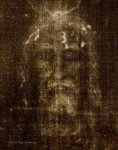According to the Jewish burial custom of the time, bodies were wrapped in strips of cloth. For example, in John 11:44, Lazarus is described as being wrapped in "linen strips."
But the accounts in the gospels differ. The synoptics take their cues from Mark, saying He was wrapped in a linen shroud provided by Joseph of Arimathea. John, however, says "they took the body of Jesus and bound it in linen cloths with the spices, as is the burial custom of the Jews."
In John 20:6-7, when Peter and John rushed to the tomb, it says: "Then Simon Peter came, following him, and went into the tomb. He saw the linen cloths lying there, and the face cloth, which had been on Jesus’ head, not lying with the linen cloths but folded up in a place by itself."
If there was a face cloth that was separate from the rest, then this obviously couldn't refer to the Shroud of Turin since it (the Shroud of Turin) is all one piece. John's gospel is the only one that records this detail.
I have mixed feelings. The shroud is a negative image of a person. If it's a forgery, how would that have even been done (in negative I mean)? But the idea of a single piece of cloth runs counter to the burial customs of the Jews at the time. However, Matthew, Mark and Luke says they wrapped Him in a linen shroud.
What are your opinions?
1



